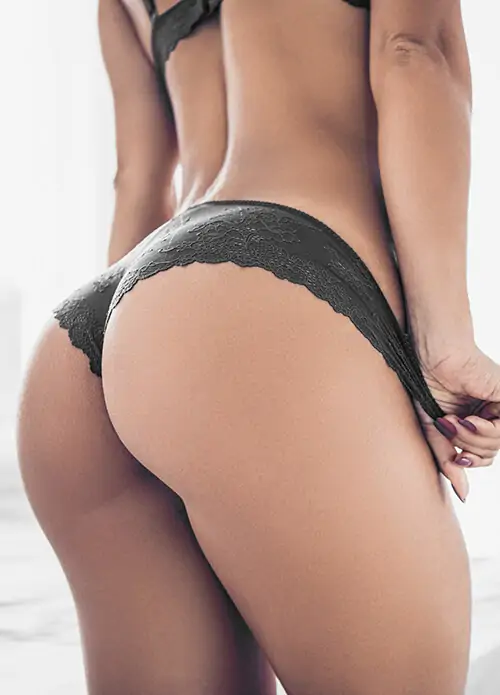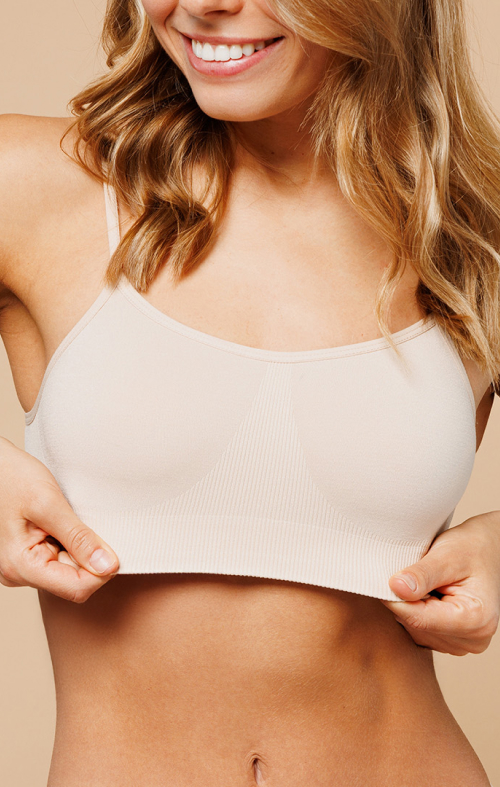Breast augmentation is a surgical procedure that enhances the size, shape, and contours of the breasts with implants.
Commonly called a “boob job,” this popular procedure has long remained one of the most frequently performed aesthetic surgeries, and nearly 300,000 women undergo breast augmentation surgeries every year. (1) Besides the appeal of having more voluminous breasts, another reason for the popularity of this surgery is that it’s customizable and versatile. Today’s breast implants are safer than ever, and come in a wide array of sizes and shapes, so women are certain to find the implant that satisfies their desires.
Dr. Steven Wallach has performed thousands of breast augmentation procedures in New York City over the course of his career, helping women achieve feminine curves they love. To find out if you are a good candidate for a breast augmentation, schedule a personal consultation at Dr. Wallach’s Manhattan offices. You can reach us by calling (929) 209-5708 or by filling out our online contact form at your convenience. If you’re ready to boost your self-confidence and feel great in every outfit you wear, let’s get the conversation started!
About Breast Augmentation
There’s no one like you. And, it’s important to work with a board-certified plastic surgeon to ensure that your breast augmentation achieves the results you desire safely while taking your individual anatomy and lifestyle into consideration. Women pursuing breast augmentations do so for a wide variety of reasons. Whether you’re looking to improve upon what Mother Nature gave you, or are looking to resolve changes to the breasts that may have occurred as the result of pregnancy and nursing, fluctuations in weight, or the aging process, a breast augmentation can help. Carefully chosen implants can also improve on existing asymmetry for more even fullness. You may be after high impact volume or just a subtle boost to your bustline, but whatever your desired result, there are implants and surgical techniques that can be tailored to suit your needs. Breast augmentation has an extremely high satisfaction rate, and studies have shown that women who underwent this procedure would be willing to undergo the surgery again. (2)
ABOUT BREAST IMPLANTS
There are typically two options for breast implants: saline or silicone. The majority of breast augmentations performed today utilize synthetic silicone implants. Today’s silicone breast implants and saline breast implants are safer than ever, and both offer a great solution for enhancing the appearance of the breasts.
Silicone Breast Implants
Silicone gel implants are designed to mimic the feeling of natural breast tissue and are constructed out of several layers of durable silicone to further minimize the risk of implant rupture and leakage. While silicone gel implants, sometimes called gummy bear breast implants, are slightly heavier than saline implants, they offer the most natural look and feel. Silicone gel implants typically hold their shape when they become damaged, which can make it harder to detect a rupture.
Saline Breast Implants
Saline breast implants are also widely used and are constructed with a durable silicone outer shell but are filled with a sterile saltwater solution that can be adjusted in volume after the implant is placed inside the body. This allows for more minor surgical scars during the implant insertion process. Saline implants have a firmer feel and will drain when ruptured, causing a noticeable difference in breast size.
While some women prefer saline implants over silicone and the other way around, the options available extend far beyond the implant material alone. When it comes to achieving the bustline of your dreams, you certainly have choices!
Testimonials
I had my first consultation with Dr. Wallach in February 2012 to discuss body-contouring procedures after massive weight loss. I had seen two plastic surgeons prior to Dr. Wallach. From the very moment that I received a phone call from the patient coordinator I knew I was in good hands. Dr. Wallach listened and answered all of my questions and was very patient. In May 2012 I had a circumferential abdominoplasty with a fleur d’lis. Dr. Wallach was there every step of the way. I had never met a doctor more dedicated to his patients. While other plastic surgeons were willing to do an entire body lift at once Dr. Wallach would not compromise his patients’ health. He is honest, caring, and above all a very competent surgeon. I would strongly recommend his care to anyone considering a procedure. He is truly an exceptional surgeon, whose expertise far outweighs other surgeons in his field. The quality of Dr. Wallach’s patient care and bedside manner is far superior to that of other plastic surgeons with whom I have consulted, and the passion he exhibits for his profession is second to none. Dr Wallach’s first priority is always patient health and safety, and is unwilling to compromise either for fiscal gain. This is not something I can say about the other plastic surgeons I consulted with, who were willing to perform any elaborate, complicated, and much more risk-laden surgery because “the price was right.” I would not go to any other surgeon and I am looking forward to my next procedure with Dr. Wallach.
Dr. Wallach is an amazing plastic surgeon and I highly recommend him to anyone looking for rhinoplasty.My daughter just had it done and we are beyond happy with the results and she is only a few weeks out!! She had very light bruising and looks absolutely beautiful.Dr. Wallach, Ashley and the rest of his staff are very professional and spent a lot of time making sure all our questions and concerns were answered.I was so nervous for my daughter and Ashely basically held my hand the whole time. I can’t thank you enough for what You did for my daughter…priceless
I was referred to and met Dr. Wallach in late January 2014 regarding having a BBL procedure done, Dr. Wallach easy going personality and professionalism put my mind at ease. I have unique medical issues and after speakina with him I knew he was the perfect physician for my procedure. My surgery was scheduled for mid-February and it went without a hitch. Mind you the day of the surgery there was a big snowstorm; but everyone on the team including myself made it in safely. Dr. Wallach was very informative on the day of surgery: explaining evey step to me and my husband. He was caring and made sure everything was being done to ensure our privacy and that I was comfortable. I must say I was very satisfied with the results and still am. I would definitely go back to Dr Wallach for any future work and would highly recommend him! His office assistant Nicole is a sweet heart and thank them both for the loving care. I have received endless compliments and owe Dr. Wallach a multitude of gratitude!!!!!
God knows I look better than when I first walked in to your office. Thank you thank you thank you for time, skills, and staff. I am beautiful again!
Breast Implant Features to Consider
SIZE
Breast implant size is measured in cc’s, or cubic centimeters, rather than cup size. The size that’s best for you will depend on the effect you’d like to achieve, and your amount of existing breast tissue. Some women may require smaller implants to reach the desired level of fullness if they currently have adequate tissue in the area, or are only seeking a subtle difference in size. But for others, larger implants may be needed to appear proportional to their shoulder and hip measurements and if little breast tissue is present. Dr. Wallach works closely with each patient to ensure that the implant size will endow optimal results.
SHAPE
Breast implants are produced in either round or anatomical shapes. Round implants are most frequently chosen by women for voluptuous fullness and cleavage. Anatomically shaped implants have a subtle slope, imparting volume that is greatest in the lower pole of the breast, and more similar to the appearance of a natural breast. However, studies have found that overtime breasts having either the round or anatomical shaped implants look about the same.
PROFILE
The profile of an implant determines how far the implant “projects” from the chest at its largest point. Your lifestyle and desired results will determine the amount of projection that’s right for you. You’ll be able to choose from moderate profile implants, moderate plus implants, high profile implants, and ultrahigh profile implants. Implants with a higher profile and more projection have a narrower base width compared to implants of the same size with a lower profile.
BREAST IMPLANT PLACEMENT
Breast implants can be placed in a breast pocket that is created below the parenchyma, or glandular mass. They can also be placed under the pectoral muscle. Dr. Wallach performs most breast augmentations using dual plane placement. This allows the implant to receive partial coverage from both the muscle and glandular tissue at ideal locations, and enjoy the benefits that each of these locations offer. (3)
INCISION LOCATIONS
In order to gain access to the ideal location for implant placement, there are a variety of incision techniques that can be used. The incision can be placed in the armpit (transaxillary), under the breast (inframammary), or the border of the areola and breast skin (periareolar). For those looking to avoid any visible scarring on the breast itself, saline breast implants can be inserted through the umbilicus (transumbilical) via tunnels that extend upwards from the incision around the navel into the breast pocket. They will be inserted empty and then filled with a sterile saline solution once they are in the proper position. This is known as a TUBA (transumbilical breast augmentation). Women that are combining breast augmentation and tummy tuck, or abdominoplasty, procedures as part of a mommy makeover can have their implants placed via the incision that is created during their tummy tuck. This is known as trans-abdominal breast augmentation or TABA. There are pros and cons to each approach, all of which can be discussed during your personal consultation with Dr. Wallach.
Candidates for Breast Augmentation with Breast Implants.
The results of a breast augmentation can be truly life-changing, but it’s important to establish your candidacy and ensure that this procedure can be performed safely to deliver the desired results.
IDEAL CANDIDATES FOR BREAST AUGMENTATION IN NEW YORK CITY ARE:
- In good overall health
- A person that desires larger breasts
- A non-smoker, or willing to quit in the weeks before their surgery and for the duration of their recovery
- Have reasonable expectations
- Are willing to commit to a responsible recovery period
- Have minimal to no sagging of the breasts.
For those with a degree of sagging, a breast lift can be performed at the same time as the breast implantation for comprehensive breast rejuvenation. The best way to determine whether you’re a good candidate for breast augmentation is to schedule a personal consultation with Dr. Wallach. If you’re ready to learn more about how to achieve the breasts of your dreams and a transformational boost to your self-esteem, why wait? Call (929) 209-5708 or fill out our online contact form to schedule an appointment.
Your personal consultation is an opportunity to learn more about breast augmentation approaches, and for Dr. Wallach to learn more about you! You’ll have the chance to discuss your aesthetic concerns, and Dr. Wallach will be able to determine the best approach to do so after a formal physical examination. After learning more about your goals and preferences, he’ll be able to suggest the best options for implant size, shape, texture, and contours. Dr. Wallach will be able to explain the various differences between saline and silicone implants, and review pocket placement, incision design, and other considerations based upon your individual anatomy. Once you’ve agreed on the details of your breast augmentation, we’ll schedule your surgery and give you detailed instructions on how to prepare.
Breast Implant Procedure
Breast Augmentations are outpatient procedures and typically take 1-2 hours to perform. Before your breast surgery begins, you’ll have a chance to review your treatment plan with Dr. Wallach, who will make sure that you’re comfortable with the details of your procedure, and looking forward to your results! Once you’ve been administered the appropriate anesthesia and it has taken effect, he’ll perform the procedure as discussed. After he has sutured the last incision closed, your chest will be bandaged, and you’ll be dressed in a supportive post-operative bra. Once the anesthesia has sufficiently worn off, you’ll be released to your designated caregiver and be able to return home to begin your recovery.
Recovery
Your trusted caregiver will need to stay with you for the first 24 hours after your breast augmentation. You will still be feeling the effects of the anesthesia, so assistance will be vital.
Most patients will have some soreness after a breast augmentation. Please take only the pain medication prescribed by Dr. Wallach in the first few days of your recovery. Patients are typically allowed to shower the next morning following surgery. Dr. Wallach recommends that patients avoid aerobic activity for about three weeks and avoid upper body heavy lifting activity for about six weeks. The majority of the swelling will have dissipated by this time. However, a small amount of residual swelling may last several months after the surgery. You can take a look at before and after pictures of Dr. Wallach’s patients to see the kind of results you’ll be able to anticipate once your recovery is complete!
How Much Does a Breast Augmentation Cost in NYC?
The price of breast augmentation varies from one plastic surgeon to another and in different parts of the country. The price of your augmentation procedure with Dr. Wallach will depend on the details of your treatment plan, and so the cost of this procedure varies slightly from patient to patient. In New York City, breast augmentations range from $8k-$15K. Looking for the cheapest plastic surgery price is highly discouraged, as people offering it at lower-than-normal rates may not have the right experience or training to perform the procedure safely. Insurance does not cover cosmetic surgery. However, if an implant is needed for a breast reconstruction then it will be covered by insurance.
Find The Best Treatment For You
Explore Our Procedures
References
- Coombs, D. M., Grover, R., Prassinos, A., & Gurunluoglu, R. (2019). Breast augmentation surgery: Clinical considerations. Cleveland Clinic Journal of Medicine, 86(2), 111–122. https://doi.org/10.3949/ccjm.86a.18017
- Fardo D, Sequeira Campos M, Pensler JM. Breast Augmentation. [Updated 2021 Oct 1]. In: StatPearls [Internet]. Treasure Island (FL): StatPearls Publishing; 2022 Jan-. Available from: https://www.ncbi.nlm.nih.gov/books/NBK482206/
- Karabeg, R., Jakirlic, M., Karabeg, A., Crnogorac, D., & Aslani, I. (2019). The New Method of Pocket Forming for Breast Implant Placement in Augmentation Mammaplasty: Dual Plane Subfascial. Medical Archives, 73(3), 178. https://doi.org/10.5455/medarh.2019.73.178-182
FAQs
Are breast implants under warranty?
The implant companies have various warranty programs for ruptures and capsular contractures. Some you have to pay for and others you do not. You have to check with each manufacturer as it varies.
Can I move my arms after breast augmentation?
Yes, you can move your arms after a breast augmentation. However, I tell my patients to avoid heavy lifting or upper body exercises for about 6 weeks after surgery.
Can breast implants cause pain years later?
Sometimes implants can cause pain years later. This is most commonly due to a capsular contracture or scar tissue around the implant.
Can you breast feed after breast augmentation
It is difficult to predict whether or not an individual will be able to breastfeed after augmentation. Some women who are very small breasted to begin with can produce a lot of milk, while some very large breasted women cannot. Inevitably during surgery some of the parenchyma is divided to create the pocket for implant placement. However, there are many patients who can breast feed. Again, this depends upon the individual patient.
Can breast implants last 30 years?
Breast implants may last 30 or more years, but many will likely need additional surgery to replace their implants at least once or twice in their lifetime.
Do breast implants cause autoimmune disease?
There are no definitive studies in the literature that I know of that prove that breast implants cause autoimmune disorders.
Do breasts sag after breast augmentation?
Breasts may sag a bit with time as the body undergoes changes as one ages. The heavier the implant, the more likely this could happen.
Do you have to replace breast implants every 10 years?
No, there is no specific time for implants to be replaced. If there is no evidence of a leak, rupture, capsular contracture, or displacement then you do not need further surgery.
How do I know if my breast implant is leaking?
A saline implant will deflate if it leaks. Identifying a leak in a silicone implant usually requires getting an MRI to determine this.
Does getting breast implants make you gain weight?
A 300 cc implant weighs about 0.66 lbs so two implants of this size is about 1.32 lbs. So, yes, you might gain a little weight with implants.
How do I prepare for breast implants?
Every surgeon is a bit different, but what I suggest to my patients is to eat healthy, stay fit, and avoid medications and herbal supplements that might cause bleeding.
Does insurance cover breast implants?
Insurance does not cover cosmetic surgery. If an implant is needed for breast reconstruction then this is usually covered by insurance.
How do you know if you have capsular contracture?
A capsular contracture usually presents with a noticeable distortion of the breast and may cause pain.
How dangerous is breast augmentation surgery?
In general, breast implant surgery is very safe with a very low risk of complications.
How long are breast augmentation incisions sore?
The breast augmentation incision usually is not painful. If the scar becomes sore, it may not be healing properly and may require attention with special tapes or possibly steroid injections.
How long do breast implants last?
Breast implants may last 30 or more years, but many will likely need additional surgery to replace their implants at least once or twice in their lifetime. There is no specific time for implants to be replaced. If there is no evidence of a leak, rupture, rippling, capsular contracture, or displacement then you do not need further surgery.
Is getting a breast augmentation worth it?
In my practice, I can not recall a single patient that ever wished that they did not have implant surgery. The majority are extremely happy to have had it done.
Is there an alternative to breast implants?
An alternative to having a breast augmentation with implants would be using your own fat to augment the breast.
How painful is breast augmentation recovery?
In general, most of my patients are pretty sore for a few days, but usually within a week they are feeling a lot better.
What are cohesive breast implants?
Cohesive gel implants are often referred to as gummy bear type implants. They are a semi-solid gel that if cut in half will stay intact.
Is breast enlargement possible without surgery?
There is no breast enlargement technique that I know of that can be performed without surgery.
What are Natrelle breast implants?
Natrelle implants are a proprietary name of a gummy type silicone implant that is produced by Allergan.
What is the most common breast implant size?
I think that will vary from practice to practice. I find that most of my patients chose somewhere between 300-450 ccs per side as the most common volume.
What can go wrong with breast implants?
The most common complications include deflation, capsular contracture, displacement, infection, and hematoma.
What is the average cost of a breast augmentation?
I think that the average price for a breast augmentation in NYC is between $8k-15K.
Will Cigna cover breast augmentation?
Insurance companies in general do not cover cosmetic breast surgery.
What is the difference between a breast augmentation and breast implants?
Breast augmentation and breast implant surgery are the same.
What is the difference between a breast lift and augmentation?
Many patients who have sagging breasts come into the office desiring breast implants thinking that adding volume to the breasts may also lift them. However, implants mainly add volume. They do not lift the breasts to any significant degree. The nipple areola complex will often stay close to the same position as where it started. If a patient has sagging breast tissue and the nipple areola complex is low, then a formal lift is most likely required. There are patients that can benefit from a breast augmentation and only need a small lift of the nipple areola complex. In those cases, I often do a circumareoolar lift, or what some refer to as a doughnut mastopexy. It is a nice procedure that can help balance asymmetries for some women, but again it has to be for the right indications. More formal lifts may employ a lollipop incision often using a vertical pedicle, or in those patients with a lot of loose skin, an inverted T or anchor incision is used. It is definitely tailored to the different individuals needs and discussed at the time of consultation.
Am I a good candidate for a breast augmentation?
In order to determine if a patient is a good candidate for a breast augmentation, they would need to be seen in the office and have a formal physical examination. During the exam, I want to learn about the goals of my patient to determine what size implant might be appropriate for her. We discuss the different options including shapes, sizes, textures, and contours of the various implants. Discussion of the various differences between saline and silicone implants are discussed as well. We review pocket placement, incision design, and various nuances based on an individual’s anatomy. Most commonly, patients come in with hypomastia, or in lay terms small breasts, and desire larger breasts. This is common in the younger patient in their early 20’s. I also see many women who have had children and their breasts have changed and sometimes become involuted. They commonly want more volume to restore the breasts as they looked prior to pregnancy. This is often in patients in their 30’s and early 40’s. But I have seen women who are older who want larger breasts as well.
Should I get a breast augmentation?
I think that deciding to undergo a surgical procedure requires a lot of thought. Fortunately, breast augmentation is a very safe procedure and I would say that patients are usually very happy they elected to have this done. I think that one has to do their research. They should learn about the types of implants available, the incisions used, the pocket position, and the potential risks, to name a few. Just as important, the patient has to find a doctor and his staff that she feels comfortable with and feels will give her a good result and proper preoperative and postoperative care. This may require a patient to meet with several doctors before deciding on a specific surgeon.
Are silicone implants better than saline implants?
Both saline breast implants and silicone breast implants are excellent products. The FDA has approved the use of silicone gel-filled implants in adults 22 years of age or older. There are advantages and disadvantages to both. Saline implants can be placed through a smaller incision than silicone implants because they are inflated inside the breast pocket. Minor volume discrepancies between the two breasts can be adjusted by filling the saline implants with different volumes of fluid but using the same shaped implants. If a saline implant deflates, the sterile saline water gets absorbed and it is usually easy to tell that it deflated. However, saline implants are usually more palpable than silicone-filled implants. Saline implants also have a fill valve which can be palpable. Silicone implants are pre-filled and do not have a palpable fill valve. Silicone implant volumes cannot be adjusted in the operating room because they cannot be opened during the procedure to be filled. Most patients feel that silicone implants feel more natural.
What is the recovery time for breast augmentation surgery?
Breast augmentation surgery is a fairly straightforward procedure for most patients. Routinely, these are performed as an outpatient in my accredited office-based surgery facility. Patients go home in a loose-fitting zip-up sports bra and often can go back to light duty fairly quickly after surgery. I most commonly perform breast augmentation using the submuscular pocket using the dual plane approach. In most cases, especially in very thin patients, I think that this adds more soft tissue coverage over the implant especially in the upper pole. Most patients can go back to light aerobics within about three to four weeks. Often they can do vigorous exercise like sit-ups and weight lifting within six to eight weeks. It is important to be seen in follow-up before moving forward with the various activities.
Will a breast augmentation lift my breasts?
Commonly patients present to my office often after having children, requesting that their breasts be restored to their pre-pregnancy appearance. Many of these patients have involution or loss of breast volume. In those patients who do not have sagging breasts, implants are an excellent choice. One fallacy is that many patients believe that if breast augmentation is performed in this type of scenario, it somehow lifts the breasts as well. In general, implants do not lift the breasts to any significant degree. Implants only restore lost volume. If a patient needs a lift, then implants alone will not accomplish this. But, sometimes fewer incisions are required for a breast lift. In other words, a patient who has a breast augmentation will perhaps get a nice result with a lollipop-type incision instead of an inverted T or anchor-type incision. Or if they were a candidate for a lollipop-type lift without implants, with implants they may only need a circumareola lift.
Can I have silicone gel implants instead of saline filled implants?
As of November 17, 2006, the FDA has approved the use of silicone gel implants for patients that desire a breast augmentation. Patients have to be at least 22 years old to receive the gel implants for primary breast augmentation. So now along with the saline-filled implants, there are even more implant choices for patients desiring a breast augmentation.
What incision can be used to place the breast implants?
There are many different ways to perform breast augmentation. The incision can be placed in the armpit (transaxillary), under the breast (inframammary), at the border of the areola and breast skin (periareolar), through the umbilicus (transumbilical), and even through an abdominoplasty incision when performing an abdominoplasty (transabdominal). Each location has its pros and cons.
Will I have normal nipple sensation after the surgery?
Many patients will have some change in sensation after the surgery; this is often due to swelling that usually resolves after four to six weeks. However, about 15% of patients will have a change in sensation that persists after one year.
Does the choice of incision location affect nipple sensation?
There have been no scientific studies in my opinion to definitively prove that incision location affects sensation. However, many plastic surgeons postulate that sensory changes may be related to the size of the implant used. That is, the larger the implant the more likely sensation will change. This may be due to the stretching of the tissues in the pocket that needs to accommodate the larger implants, and therefore stretching the sensory nerves may affect the function of these nerves.
What size breast implants should I get?
I always tell prospective patients who email me this request that I cannot predict the exact size of the cup in a bra because bras do not always match up to the volumes of implants. Furthermore, the implants appear differently for different patients. A good guesstimate is to perform a BAGGY TEST once the potential range of volumes is discussed with me during consultation.
What is a baggy test?
A baggy test is a test that I sometimes have patients do at home after discussing breast implant options to nail down a volume that they might be happy with for breast augmentation. Basically, patients get a plastic bag that can twist-tie. I have them fill up the bag with either rice or water. They fill a measuring cup to the suggested volume and then pour that volume in the bag and tie it. They then put on a loose fitting bra, preferably one that they want to fill, and then add the filled bag into the bra cup. Then they put a tight t-shirt on over the bra to see if they like that volume. Changing the volume as suggested in specific increments may help in the decision making process for the final implant volume. It produces a rough estimate and seems to work for my patients in most cases.
What type of breast implant is best for me?
Today we have so many options for breast augmentation. Not only do we have saline, or sterile water-filled implants, but we also have silicone-filled implants both with cohesive gel and form stable silicone gel. Furthermore, we have different surfaces covering the implants. This includes both smooth and textured surfaces. There are also different implant profiles including low profile, moderate profile, high profile, and ultrahigh profile. Besides round implants, we also have available biodimensional or anatomic-shaped implants. This variety gives patients many different options to choose from.
Should I get an anatomical shaped implant?
Anatomical shaped implants or biodimensional implants have a teardrop shape to them. In the U.S. they are all textured. These are great implants for some patients. The main disadvantage in my opinion is that they can rotate a bit and may not stay in the orientation that they were placed in the operating room.
What is a TABA?
TABA stands for Trans-Abdominal Breast Augmentation. This is an approach using the abdominoplasty incision to gain access for insertion of breast implants. I have used this technique in patients who underwent a mommy makeover. A mommy makeover usually refers to a procedure that a woman has after completing having children. It usually entails a combination of a breast procedure and a tummy tuck. A TABA is great for a patient that wants a tummy tuck and a breast augmentation at the same time and they do not have breast ptosis (sagging.) A small pocket is created, extending up to each breast from the upper aspect of the elevated abdominal flap. Once this is completed, the implants are placed into the pocket. The advantage is that there are no incisions on or near the breast. Saline or silicone breast implants can be placed through this approach.
What is a TUBA?
TUBA stands for TransUmbilical Breast Augmentation. This was a very popular procedure when only saline implants were available on the market. A small incision is made in the umbilicus and a tube is maneuvered into the space up to the breast fold. Using an endoscope to visualize the pocket position, an implant is then inserted. Because a small tunnel is used, saline implants are the only ones inserted this way. Disadvantages include the limited access afforded by this technique which limits the ability to treat bleeding, or allow for precise pocket dissection. Silicone implants cannot be placed through this approach.
Can I get a breast implant without a lift?
In general, if you need a breast lift then you need a lift. Implants provide more volume and will not raise the nipple to any great degree. Sometimes a patient can have a circumareolar lift in which an incision is made around the border of the areola to raise it higher on the breast mound. If the patient needs more of a lift, then a vertical or inverted T-type closure can be performed. It really depends upon the patient’s anatomy.
What breast implant volume is best for me?
Choosing the right breast implant for an individual is a complex decision process. First, the patient’s goals are of prime importance. What size do they want? What shape are they looking for? What type of projection are they looking for? etc… However, a very important factor is the patient’s overall anatomy. How wide is the chest wall? What volume of breast tissue do they have? How loose is the skin? How thick is the skin? to name a few. Once all this information is taken into consideration, a range of implants is selected for possible use. I will often have the patients perform a baggy test at home to see if they like the volume chosen. Then in the operating room, I will have several different sizes and shapes of implants to choose from based upon all these factors, and then use the information obtained during consultation and what I see in the operating room to make the final decision.
What profile breast implant is right for me?
Choosing the right breast implant profile is best performed in person during a physical exam and a discussion of the patient’s goals. Implants used to come in only one shape and with increasing volume, the implant got wider and had more projection. Now for any volume, there are several different shapes to choose from. We have moderate profile implants, moderate plus implants, high profile implants, and ultrahigh profile implants. So as the profile changes, and for the same volume, the base width of the implant becomes narrower and the projection becomes greater.
How do you treat rippling of a breast implant?
Rippling of an implant happens more commonly in thinner patients who do not have a lot of soft tissue coverage over the breast implant. For patients that have subglandular breast implants, this can happen along any surface of the implant. With implants under the muscle, the upper pole has more soft tissue coverage because it not only is covered by the skin and breast gland but in addition, it is covered by the pectoralis muscle. Patients with submuscular implants tend to have rippling along the lower pole where the muscle does not cover the implant. Treating rippling depends upon the breast implant pocket position. If the implant is subglandular, then perhaps placing them submuscular can help. In addition, the lower pole will still need more coverage. This can be achieved with an acellular dermal matrix (ADM), most commonly Strattice. This matrix adds another layer of coverage over the implant and incorporates it into the surrounding soft tissue. Some surgeons may offer fat injection as another alternative to thicken the soft tissue surrounding the implants to decrease the rippling.
What is a double bubble and how do you treat it?
A double bubble is a breast deformity that occurs when an implant either is too wide for the native breast mound and does not drape appropriately over the implant or when the implant drifts down below the natural inframammary fold. For the former situation, one can have the lower pole of the breast opened up by scoring the gland so that it re-drapes better over the implant, or placing a smaller implant in the pocket that matches the breast base diameter better. This also may require a capsule repair to accommodate the smaller implant. For the latter situation, if the implant drifts down below the natural fold, it may be because the inframammary fold was undermined during the original surgical approach or the implant pushed through the weak inframammary fold. Either way, a capsulorrhaphy or pocket repair will need to be performed. Sometimes a smaller implant is recommended as well to be replaced into the pocket. Some surgeons will also use an acellular dermal matrix (ADM) to provide extra support for the pocket repair.
How do you treat a capsular contracture?
The body forms a natural barrier around implants of all types. Usually, this pocket stays pliable and soft for most patients. However, for some, the capsule around the implant can become tight. One theory regarding the cause is that there is a low-level bacterial count in the pocket, leading to a biofilm layer that causes the capsule to tighten. This tightening is called a capsular contracture. Rates of capsular contracture are reported to be between 5-15%, and there is a high risk of recurrence once it develops and is treated. Treatment of a capsular contracture usually entails removing the implant, removing as much of the capsule as possible, and then replacing it with a new implant. There have been some reports that suggest placing the implant in a submuscular pocket may decrease the risk of contracture. In addition, some reports suggest that using an acellular dermal matrix (ADM), like Strattice may help reduce the risk of recurrence.
What is symmastia?
Symmastia is a condition in which the natural central depression over the sternum that separates the two breasts is violated and the area lifts up to give the appearance of one very large breast. This happens as a result of implant malposition, more common when implants are placed in a subglandular pocket. Usually, in a submuscular pocket, the implant is blocked or restricted from moving more medially because of the natural insertion of the pectoralis muscle on to the sternum. Symmastia may develop in individuals when the surgeon attempts to produce more cleavage for the patient. Treatment of symmastia often includes a capsulorrhaphy or pocket repair. Some surgeons may add an acellular dermal matrix (ADM), such as Strattice to reinforce the pocket repair. If the implant is in the subglandular plane, placing it in a submuscular plane may be beneficial.
Textured vs smooth breast implants?
Breast implants can have a smooth outer surface or a textured outer surface. The rationale for the textured outer surface is that it potentially could help minimize the risk of developing a capsular contracture. The truth is that the literature does not support this concept in many studies, especially when the implants are placed in a submuscular pocket. Furthermore, textured implants tend to not move as freely in the pocket as a smooth implant.
How do you treat breast implant malposition?
Malposition of a breast implant can entail a lot of different concepts including lateralization, medialization leading to symmastia, and bottoming out inferiorly. In all cases, the pocket has to be adjusted so that these problems do not recur. Sometimes the creation of a new pocket is necessary and is called a neo-subpectoral pocket. Many times the old pocket can be used, and repair or tightening of the pocket can be performed which is called a capsulorrhaphy. In some instances, an acellular dermal matrix (ADM), such as Strattice is used to reinforce the pocket repair.
Can I have more cleavage?
Cleavage is defined by the space between the two breasts that lies over the sternum. The patient’s anatomy dictates the amount of cleavage they can have. Wider implants may help improve the cleavage. Some surgeons will place the implants in a subglandular plane to improve the cleavage. When the pocket is made too aggressively medially, then symmastia may develop. When implants are placed under the muscle, the cleavage is limited to the insertion point of the overlying pectoralis muscle, and so the amount of cleavage achieved can be limited.
Is a gummy implant better than silicone?
Gummy implants are form-stable implants. They differ from the more common cohesive gel implants in that they are firmer. The form-stable implants maintain the structure of the gel if the implant ruptures. The analogy used is that the consistency is like jello. If the implant is cut in half, the gel does not ooze. The form-stable implants available in the U.S. are all textured and have a Bio-Dimensional shape. Because of their somewhat lack of pliability, a larger incision is required to insert them as opposed to the incision size used for the cohesive gel implants or the saline implants.
What are Gummy Bear Implants?
Gummy bear implants are implants that are made of a semi-solid type of silicone that remains intact when the implant is cut in half. Natrelle implants are a proprietary name of a gummy-type silicone implant that is produced by Allergan. As of November 17, 2006, the FDA has approved the use of silicone gel implants for patients who desire a breast augmentation. Patients have to be at least 22 years old to receive the gel implants for primary breast augmentation. So now along with the saline-filled implants, there are even more implant choices for patients desiring a breast augmentation.
Can fat be transferred to the breasts?
Yes, can fat be transferred to the breasts for augmentation. It is not my preferred method for primary augmentation but I offer it to patients as an alternative to implants.
How much does a breast augmentation cost?
The fee for breast augmentation will vary from doctor to doctor. In NYC the fee can run from about $8-15K.
What is the safest breast implant?
In my opinion, there is no one safest breast implant that I know of.












